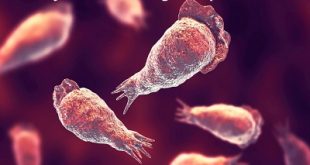Definition
Pancreatic cancer begins in the tissues of your pancreas an organ in your abdomen that lies horizontally behind the lower part of your stomach. Your pancreas releases enzymes that aid digestion and hormones that help manage your blood sugar.
Pancreatic cancer typically spreads rapidly to nearby organs. It is seldom detected in its early stages. But for people with pancreatic cysts or a family history of pancreatic cancer, some screening steps might help detect a problem early.
Epidemiology
Worldwide, pancreatic cancer ranks 13th in incidence but 8th as a cause of cancer death. Most other countries have incidence rates of 8-12 cases per 100,000 persons per year. In some areas of the world, pancreatic cancer is quite infrequent; for example, the incidence in India is less than 2 cases per 100,000 persons per year.
Types
There are two types of pancreatic cancer, that of the exocrine gland and that of the endocrine gland. About 95 percent of pancreatic cancers begin in the exocrine (enzyme-producing) cells of the pancreas.
Exocrine tumors: Most tumors affecting the exocrine gland are called adenocarcinomas. This type of cancer forms in the pancreas ducts. Treatment for these tumors is based on stage of growth.
Endocrine tumors: These tumors are less common and are most often benign. Though rare, cancer stemming from a pancreatic endocrine tumor (PET) affects the hormone-producing cells. These tumors are also called islet cell tumors or neurendocrine tumors.
Risk factors of pancreatic cancer
Factors that may increase your risk of pancreatic cancer include:
- Chronic inflammation of the pancreas (pancreatitis)
- Diabetes
- Family history of genetic syndromes that can increase cancer risk, including a BRCA2 gene mutation, Lynch syndrome and familial atypical mole-malignant melanoma (FAMMM) syndrome
- Family history of pancreatic cancer
- Smoking
- Obesity
- Older age, as most people are diagnosed after age 65
A large study demonstrated that the combination of smoking, long-standing diabetes and a poor diet increases the risk of pancreatic cancer beyond the risk of any one of these factors alone.
Causes
- Pancreatic cancer develops when a cell in the pancreas acquires damage to its DNA that causes it to behave and multiply abnormally. A single cancer cell grows and divides rapidly, becoming a tumor that does not respect normal boundaries in the body. Eventually, cells from the tumor travel elsewhere in the body (metastasize) through the blood or lymphatic system.
- No one knows exactly how the process of DNA damage leading to pancreatic cancer occurs. Analyzing pancreatic cancers removed by surgery shows certain mutations that occur in nearly all cases, and others that vary between people.
- Some of these mutations occur randomly. Others occur in response to things we do or experience in the environment. Some mutations may be inherited. When enough mutations accumulate, a cell becomes malignant and a tumor begins to grow.
Symptoms of pancreatic cancer
Classic pancreatic cancer symptoms can include:
- Painless jaundice (yellow skin/eyes, dark urine, itching). This is related to bile duct obstruction
- Weight loss which is significant and unexplained
- Abdominal pain which is new-onset and significant
Other possible symptoms of pancreatic cancer:
- Pain in the upper abdomen that radiates to the back which is new, significant and persistent that is relieved by leaning forward
- Back pain
- Diabetes which is new-onset and not associated with weight gain
- Vague indigestion (dyspepsia) or abdominal discomfort (not responding to prescribed medication)
- Loss of appetite
- Nausea and vomiting
- Pain when eating
- Steatorrhea (fatty stools that are often pale and smell foul)
Not everyone will have all of these symptoms. For example, those who have a tumour in the body or tail of the pancreas are unlikely to have painless jaundice. All of these symptoms can have other causes, and there is not yet a reliable and easy test for pancreatic cancer.
Diagnosis and test
Your GP will first ask about your general health and carry out a physical examination. They may examine your tummy (abdomen) for a lump and to see whether your liver is enlarged.
They’ll also check your skin and eyes for signs of jaundice and may request a urine sample and blood test.
If your GP suspects pancreatic cancer, you’ll usually be referred to a specialist at a hospital for further investigation. You may have either:
- An ultrasound scan
- A computerised tomography (CT) scan
- A magnetic resonance imaging (MRI) scan
- A positron emission tomography (PET) scan – where you’re given an injection of a very small amount of radioactive medication, known as a tracer, which helps to show up cancers in an image
Depending on the results of a scan, further tests may include:
- An endoluminal ultrasonography (EUS) endoscopy – a type of endoscopy which allows close-up ultrasound pictures to be taken of your pancreas
- An endoscopic retrograde cholangiopancreatography (ERCP) – a type of endoscopy which is used to inject a special dye into your bile and pancreatic ducts; the dye will show up on an X-ray and highlight any tumours
- A laparoscopy – a surgical procedure that allows the surgeon to see inside your body using a laparoscopy (a thin, flexible microscope)
A biopsy, where a small sample is taken from a suspected tumour, may also be carried out during these procedures.
Stages of pancreatic cancer
The stages of pancreatic cancer are:
Stage I. Cancer is confined to the pancreas and can be removed using surgery.
Stage II. Cancer has spread beyond the pancreas to nearby tissues and organs and may have spread to the lymph nodes. At this stage, surgery may be possible to remove the cancer.
Stage III. Cancer has spread beyond the pancreas to the major blood vessels around the pancreas and may have spread to the lymph nodes. Surgery may or may not be possible to remove the cancer at this stage.
Stage IV. Cancer has spread to distant sites beyond the pancreas, such as the liver, lungs and the lining that surrounds your abdominal organs (peritoneum). Surgery isn’t an option at this stage.
Don’t hesitate to ask your doctor about his or her experience with diagnosing pancreatic cancer. If you have any doubts, get a second opinion.
Treatment and medications
Cancer of the pancreas is difficult to treat. It rarely causes any symptoms in the early stages, so it’s often not detected until the cancer is fairly advanced. If the tumour is large, treating the cancer will be more difficult.
If you’ve been diagnosed with pancreatic cancer, your treatment will depend on the type and location of your cancer, and how far it’s advanced. Your age, general health and personal preferences will also be taken into consideration.
The first aim will be to completely remove the tumour and any other cancerous cells. If this isn’t possible, treatment will focus on preventing the tumour growing and causing further harm to your body.
The three main treatments for pancreatic cancer are:
- surgery
- chemotherapy
- radiotherapy
Some types of pancreatic cancer only require one form of treatment, whereas others may require two types of treatment or a combination of all three.
Surgery
Recovering from pancreatic cancer surgery can be a long and difficult process.
- You’ll probably experience some pain after your operation. The staff at your hospital will make sure you have adequate pain relief.
- After any type of surgery to your digestive system, your bowel will temporarily stop working. This means you won’t be able to eat or drink straight away.
- You’ll gradually be able to sip fluids, before eventually being able to drink and eat more regularly. You may be referred to a dietitian, who can advise you about what foods you should eat following your operation.
- After the tumour has been removed, you’ll probably have a six-month course of chemotherapy, which greatly increases your chance of being cured. But because cancer of the pancreas is difficult to diagnose and treat, many people don’t recover completely.
- Treatment can be very effective in helping to ease symptoms and make you as comfortable as possible. Chemotherapy can help shrink your tumour and slow down its growth.
Prevention of pancreatic cancer
There are no established guidelines or recommendations for preventing pancreatic cancer, according to the American Cancer Society. However, it is advisable to quit smoking because cigarette use is thought to be a main factor in 20-30% of pancreatic cancers. In general, physicians recommend standard preventive measures such as keeping a healthy weight, exercising, and increasing consumption of fruits, vegetables, and whole grains while decreasing red meat intake. There is no evidence, however, that following these dietary guidelines will prevent or reduce pancreatic cancer.
Some studies suggest that certain vitamins can reduce the risk of pancreatic cancer. Vitamin D has been associated with reducing the risk of several types of cancer, including pancreatic cancer. B vitamins such as B12, B6, and folate that are consumed in food (not in pill or tablet form) have also been suggested to reduce pancreatic cancer risk.
 Diseases Treatments Dictionary This is complete solution to read all diseases treatments Which covers Prevention, Causes, Symptoms, Medical Terms, Drugs, Prescription, Natural Remedies with cures and Treatments. Most of the common diseases were listed in names, split with categories.
Diseases Treatments Dictionary This is complete solution to read all diseases treatments Which covers Prevention, Causes, Symptoms, Medical Terms, Drugs, Prescription, Natural Remedies with cures and Treatments. Most of the common diseases were listed in names, split with categories.








i enjoyed this thesis and need to know weather pancreatic cancer is related with ulcers